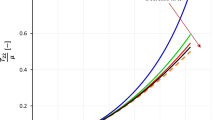Abstract
The purpose of this paper is to construct the general forms for constitutive equations for residually stressed hyperelastic bodies that are composed of material with a specified symmetry. The effective mechanical properties of a material comprising a residually stressed body are dependent on both the intrinsic material properties of the underlying natural material and on the residual stress field itself. Thus, prediction of the mechanical behavior of a residually stressed body typically requires a constitutive model that explicitly includes the influence of the residual stress for deformations out of the residually stressed configuration. In this paper, constitutive equations are derived for the cases where the underlying natural material is transversely isotropic or orthotropic, two material symmetries of special interest in the description of biological tissues. In addition, it is established that the method used in the derivation can be applied to materials with any symmetry for which an integrity basis is known. The derivation requires that the constitutive equation for the underlying natural material be known and that the restriction of the response function to the set of positive definite symmetric tensors be locally invertible. The resulting constitutive equations are expressed as functions of the residual stress and the deformation gradient out of the residually stressed configuration. A major advantage of the method is that the only material parameters in the constitutive equation are those of the underlying stress free material.
Similar content being viewed by others
References
Y.C. Fung, Biomechanics: Motion, Flow, Stress, and Growth. Springer-Verlag (1990).
B.E. Johnson and A. Hoger, The use of a virtual configuration in formulating constitutive equations for residually stressed elastic materials. J. Elasticity 41 (1995) 177–215.
A. Hoger, On the residual stress possible in an elastic body with material symmetry. Arch. Rat. Mech. Anal. 88 (1985) 271–290.
A. Hoger, The constitutive equation for finite deformations of a transversely isotropic hyperelastic material with residual stress. J. Elasticity 33 (1993) 107–118.
E.K. Rodriguez, J.H. Omens, L.K. Waldman and A.D. McCulloch, Effect of residual stress on transmural sarcomere length distribution in rat left ventricle. Amer. J. Physiology 264 (1993) H1048–H1056.
A.D. McCulloch, Cardiac biomechanics. In: J.D. Bronzino (ed.), Biomedical Engineering Handbook (1995) pp. 418–439.
B.H. Smaill and P.J. Hunter, Structure and function of the diastolic heart: Material properties of passive myocardium. In: L. Glass, P.J. Hunter and A.D. McCulloch (eds), Theory of Heart: Biomechanics, Biophysics, and Nonlinear Dynamics of Cardiac Function (1991) pp. 1–29.
J. Humphrey, R. Strumpf, H. Halperin, and F. Yin, Toward a stress analysis in the heart. In: L. Glass, P.J. Hunter and A.D. McCulloch (eds), Theory of Heart: Biomechanics, Biophysics, and Nonlinear Dynamics of Cardiac Function (1991) pp. 59–75.
D.D. Streeter, Jr., Gross morphology and fiber geometry of the heart. In: R.M. Berne (ed.), Handbook of Physiology, Section 2: The Cardiovascular System (1979) pp. 61–112.
I.J. LeGrice, B.H. Smaill, L.Z. Chai, S.G. Edgar, J.B. Gavin and P.J. Hunter, Laminar structure of the heart: ventricular myocyte arrangement and connective tissue architecture in the dog. Amer. J. Physiology 269 (1995) H571–H582.
I.J. LeGrice, Y. Takayama and J.W. Covell, Transverse shear along myocardial cleavage planes provides a mechanism for normal systolic wall thickening. Circulation Res. 77 (1995) 182–193.
P.M.F. Nielsen, I.J. LeGrice, B.H. Smaill and P.J. Hunter, Mathematical model of geometry and fibrous structure of the heart. Amer. J. Physiology 260 (1991) H1365–H1378.
M. Gurtin, Introduction to Continuum Mechanics. Academic Press (1984).
R.W. Ogden, Non-Linear Elastic Deformations. Ellis Horwood (1984).
R.S. Rivlin, Further remarks on the stress-deformation relations for isotropic materials. J. Rat. Mech. Anal. 4 (1955) 681–702.
A.J.M. Spencer, Theory of Invariants. In: A.C. Eringen (ed.), Continuum Physics 1, Academic Press (1971).
J.E. Adkins, Symmetry relations for orthotropic and transversely isotropic materials. Arch. Rat. Mech. Anal. 4 (1960) 193–213.
A.S. Wineman and A.C. Pipkin, Material symmetry restrictions on constitutive equations. Arch. Rat. Mech. Anal. 17 (1965) 184–214.
A.C. Pipkin and A.S. Wineman, Material symmetry restrictions on non-polynomial constitutive equations. Arch. Rat. Mech. Anal. 12 (1962) 420–426.
A.E. Green and J.E. Adkins, Large Elastic Deformations. Clarendon Press (1970).
J.E. Adkins, Further symmetry relations for transversely isotropic materials. Arch. Rat. Mech. Anal. 5 (1960) 264–274.
G.F. Smith and R.S. Rivlin, The strain-energy function for anisotropic elastic materials. Amer. Math. Soc. 88 (1958) 175–193.
Author information
Authors and Affiliations
Rights and permissions
About this article
Cite this article
Hoger, A. Virtual Configurations and Constitutive Equations for Residually Stressed Bodies with Material Symmetry. Journal of Elasticity 48, 125–144 (1997). https://doi.org/10.1023/A:1007459331524
Issue Date:
DOI: https://doi.org/10.1023/A:1007459331524




